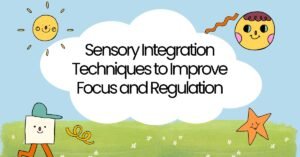Early intervention plays a crucial role in addressing speech and language issues in children. It refers to the prompt identification and treatment of communication challenges to enhance a child’s overall development. This article explores the significance of early intervention in speech therapy and its positive impact on children’s lives.
Benefits of Early Intervention
Early intervention programs offer a range of benefits that contribute to a child’s holistic development. By addressing speech and language challenges early on, these programs:
- Improve Communication Skills: Early intervention helps children develop clear speech, expressive language, and effective communication strategies.
- Enhance Cognitive Development: It fosters cognitive abilities such as problem-solving, memory, and critical thinking through structured therapy sessions.
- Facilitate Social Interaction: Children learn social skills, turn-taking, and peer interaction, leading to improved relationships and social confidence.
- Promote Emotional Growth: Effective communication reduces frustration and enhances self-esteem, emotional regulation, and overall well-being.
Types of Early Intervention Programs
Early intervention encompasses various therapeutic approaches tailored to meet individual needs:
- Speech-Language Therapy: Focuses on improving speech articulation, language comprehension, and communication fluency.
- Applied Behavior Analysis (ABA) Therapy: Addresses behavior and communication challenges through structured interventions and positive reinforcement techniques.
- Auditory Verbal Therapy (AVT): Enhances auditory processing and listening skills, crucial for language development and speech clarity.
- Occupational Therapy: Targets motor skills, sensory integration, and functional abilities to support overall communication and daily living skills.
Signs that Indicate the Need for Early Intervention
Parents and caregivers should be aware of common signs that may indicate the need for early intervention:
- Delayed Speech Development: Limited vocabulary, difficulty forming sentences, or unclear speech sounds.
- Language Comprehension Challenges: Trouble following instructions, understanding concepts, or expressing thoughts coherently.
- Social Interaction Difficulties: Struggles with peer interaction, making eye contact, or engaging in age-appropriate conversations.
Impact of Early Intervention on Children
Numerous studies highlight the positive outcomes of early intervention programs:
- Improved Communication: Children show progress in speech clarity, language comprehension, and expressive abilities.
- Enhanced Academic Performance: Early intervention lays a strong foundation for academic success, including reading and writing skills.
- Positive Social Engagement: Children develop confidence, social skills, and peer relationships, leading to improved social integration.
Challenges and Solutions
While early intervention is beneficial, it may face challenges such as:
- Financial Constraints: Access to affordable therapy services and insurance coverage can be a barrier for some families.
- Accessibility Issues: Rural areas or underserved communities may have limited access to qualified professionals and therapy facilities.
- Parental Involvement: Active involvement and consistent support from parents are crucial for the success of early intervention programs.
To address these challenges, collaboration between healthcare providers, educators, and policymakers is essential. Financial assistance programs, teletherapy options, and community outreach initiatives can improve access to early intervention services.
The Role of Technology
Advancements in technology has revolutionized early intervention strategies:
- Telepractice: Remote therapy sessions allow children to receive interventions from the comfort of their homes, expanding access to services.
- Digital Tools: Speech therapy apps, interactive games, and online resources supplement traditional therapy sessions, enhancing engagement and outcomes.
Conclusion
Early intervention in speech therapy is a proactive approach that empowers children with the skills they need for academic, social, and emotional success. By addressing communication challenges early on, we can unlock a child’s full potential and promote inclusive growth.
Frequently Asked Questions (FAQs)
1. What age is considered early intervention for speech therapy?
Early intervention typically begins as early as infancy or toddlerhood, focusing on identifying and addressing communication delays promptly.
2. How can parents encourage speech and language development at home?
Engage in daily conversations, read aloud, use gestures, and provide opportunities for interactive play to support speech and language skills.
3. Are there any risks associated with early intervention programs?
Early intervention programs are tailored to meet individual needs and are designed to be safe and effective, with minimal risks when implemented by qualified professionals.
4. Can early intervention programs be tailored to individual needs?
Yes, early intervention programs are personalized to address specific communication challenges, developmental milestones, and learning styles of each child.
5. What should parents look for when choosing an early intervention program?
Look for accredited programs, experienced therapists, evidence-based practices, family involvement opportunities, and a supportive learning environment.






